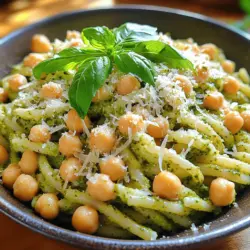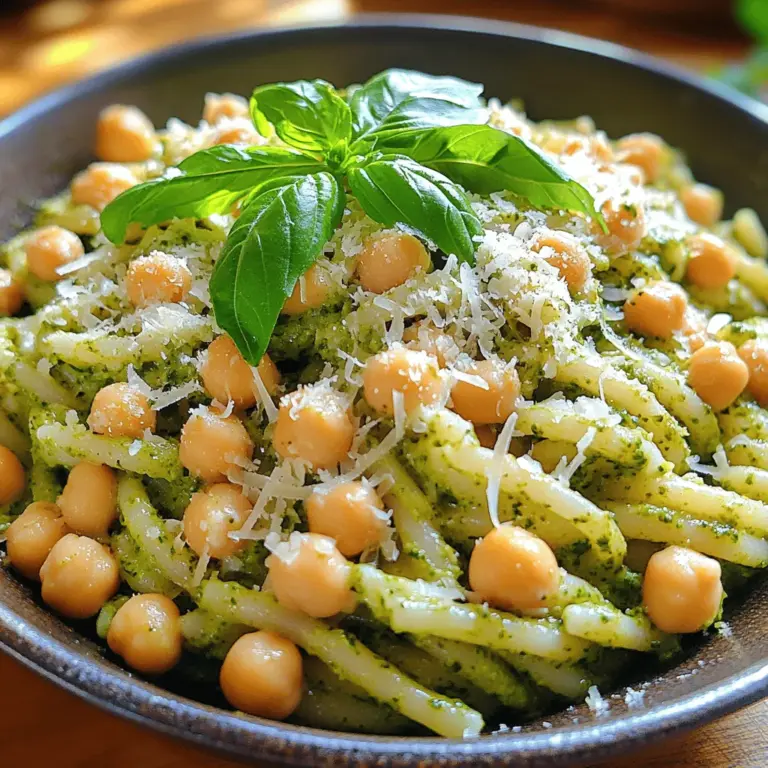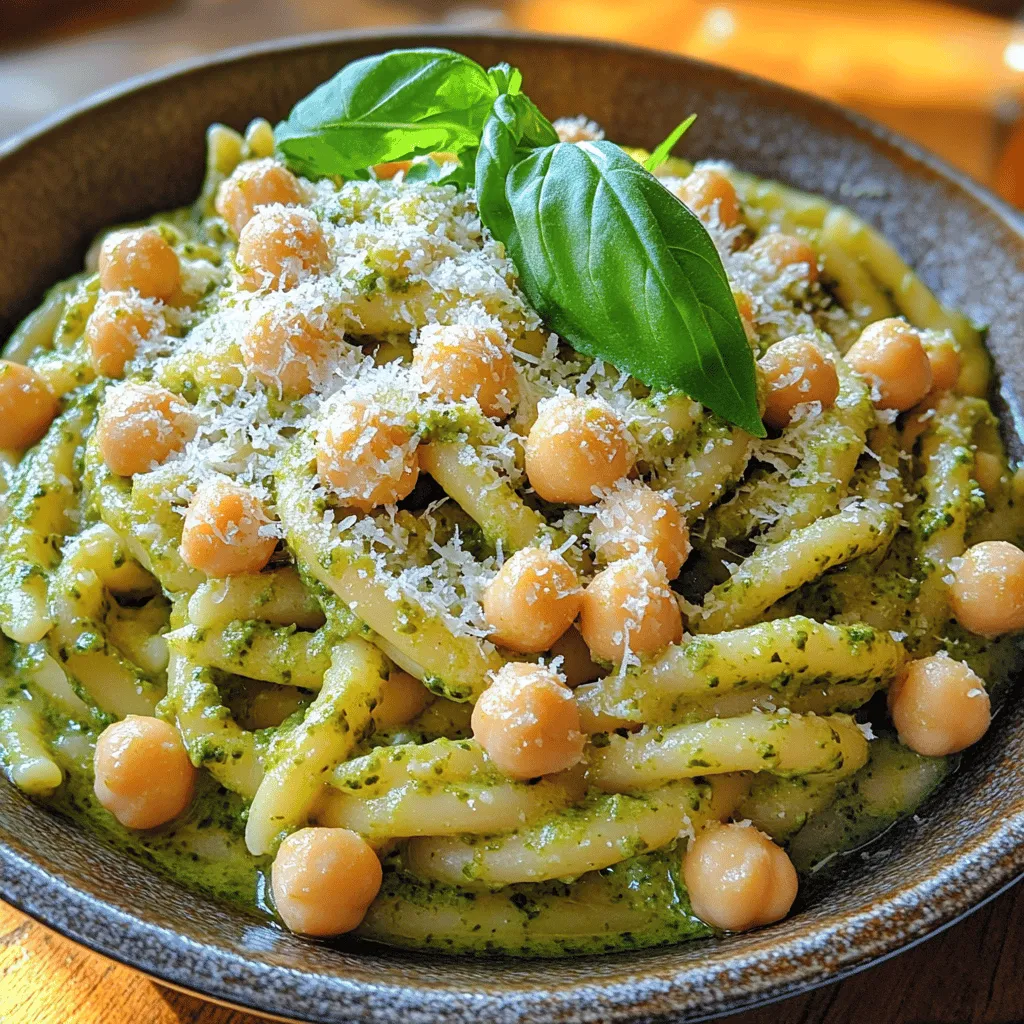Creamy Pesto Chickpea Pasta Delight: A Flavorful and Nutritious Dish
If you’re looking for a dish that is both satisfying and nourishing, look no further than creamy pesto chickpea pasta. This delightful recipe expertly combines the vibrant flavors of fresh basil with the creamy textures derived from a variety of ingredients, creating a meal that is not only delicious but also packed with nutrition. The star of this dish, chickpeas, play a crucial role, providing a rich source of protein and fiber, making it a perfect option for those following vegetarian or vegan diets.
One of the standout features of creamy pesto chickpea pasta is its versatility. Whether you’re a seasoned chef or a beginner in the kitchen, this recipe is straightforward and easy to prepare. It lends itself well to various dietary preferences, offering alternative ingredients to cater to vegans and those needing gluten-free options. This dish is not just a meal; it’s a celebration of flavors and textures that can be tailored to suit any palate.
Understanding the Ingredients
To truly appreciate the creamy pesto chickpea pasta, it’s essential to understand the core ingredients that contribute to its delightful flavor and nutritional profile.
– Fresh Basil: The aromatic qualities of fresh basil are the backbone of any pesto. This fragrant herb is not only a flavor powerhouse but also boasts numerous health benefits. Basil is rich in antioxidants, which help combat oxidative stress in the body. It contains essential oils such as eugenol, which may have anti-inflammatory properties, making it a great addition to your diet for overall wellness.
– Chickpeas: Also known as garbanzo beans, chickpeas are a staple in many vegetarian and vegan dishes. They are an excellent source of plant-based protein, making them a fantastic substitute for meat. Chickpeas are loaded with dietary fiber, which promotes digestive health and helps keep you feeling full longer. Their versatility means they can be used in a myriad of dishes, from salads to stews, but in this recipe, they shine as the main protein source.
– Olive Oil: Extra virgin olive oil, a key ingredient in pesto, is renowned for its health benefits. It is rich in monounsaturated fats, which are heart-healthy and may help lower bad cholesterol levels. Additionally, olive oil contains antioxidants such as vitamin E, which contribute to skin health and may reduce inflammation. Using high-quality olive oil can elevate the flavor of your dish, making it richer and more satisfying.
– Parmesan Cheese and Nutritional Yeast: For those who enjoy dairy, freshly grated Parmesan cheese adds a savory depth to the dish. Its umami flavor enhances the overall taste of the creamy pesto. However, for a dairy-free alternative, nutritional yeast provides a cheesy flavor without the dairy. Packed with B vitamins and often fortified with additional nutrients, nutritional yeast is an excellent choice for vegans, adding not just flavor but also nutritional value.
– Heavy Cream vs. Coconut Cream: The choice of cream can significantly affect the flavor and texture of your dish. Heavy cream brings a luxurious creaminess that is hard to beat, while coconut cream offers a dairy-free alternative with a subtly sweet flavor. For those looking to avoid dairy, coconut cream can introduce a tropical note that complements the basil beautifully. Each option has its merits, and you can choose based on your dietary needs and flavor preferences.
The Importance of Pasta Choice
While the sauce and ingredients are critical to the success of creamy pesto chickpea pasta, the type of pasta you choose also plays a significant role in the overall dish.
– Types of Pasta: Pasta shapes like penne or fusilli are ideal for this recipe. Their tubular or spiral forms allow them to hold onto the creamy pesto sauce, ensuring that each bite is bursting with flavor. The right pasta can make a substantial difference in the dining experience, making it essential to select a shape that complements the dish.
– Gluten-Free Options: For those with gluten sensitivities or celiac disease, there are many gluten-free pasta alternatives available. Options made from rice, quinoa, or chickpeas can provide a similar texture and taste. These alternatives ensure that everyone can enjoy the creamy pesto chickpea pasta without compromising on flavor or health.
Step-by-Step Cooking Process
Now that we’ve explored the ingredients and their benefits, it’s time to dive into the cooking process. This step-by-step guide will help you prepare creamy pesto chickpea pasta with ease.
1. Prepare the Pesto: Start by blending fresh basil leaves, garlic, extra virgin olive oil, nuts (like pine nuts or walnuts), and Parmesan cheese (or nutritional yeast) in a food processor until smooth. Adjust the consistency with more olive oil if necessary, and season with salt and pepper to taste.
2. Cook the Pasta: Bring a large pot of salted water to a boil. Add your pasta of choice (penne, fusilli, or gluten-free alternatives) and cook according to package instructions until al dente. Be sure to reserve a cup of pasta water for later use.
3. Sauté the Chickpeas: In a large skillet, heat a tablespoon of olive oil over medium heat. Add canned or cooked chickpeas and sauté until they are slightly crispy, about 5-7 minutes. This step enhances their flavor and texture, making them a delightful addition to your dish.
4. Combine Ingredients: Once the pasta is cooked, drain it and add it directly to the skillet with the chickpeas. Pour in the prepared pesto, mixing gently to coat the pasta and chickpeas. If the mixture appears too thick, add a splash of the reserved pasta water to achieve your desired consistency.
5. Finish with Cream: For an extra creamy texture, stir in your choice of heavy cream or coconut cream. Mix until everything is evenly combined and heated through.
This introduction to creamy pesto chickpea pasta sets the stage for a flavorful, nutritious meal that is easy to prepare and perfect for any occasion. Whether you’re cooking for family, friends, or simply indulging in a personal favorite, this dish is sure to impress with its rich flavors and wholesome ingredients. Stay tuned for the next part of this article, where we will explore variations and serving suggestions to elevate your creamy pesto chickpea pasta experience.
Cooking the Pasta
To achieve the perfect al dente texture for your pasta, start by bringing a large pot of salted water to a rolling boil. The general rule of thumb is to use about 1 tablespoon of salt for every 4-6 quarts of water. This not only enhances the flavor of the pasta but also helps it maintain its texture during cooking. Once the water is boiling, add your pasta and stir immediately to prevent sticking.
Cook the pasta according to the package instructions, typically around 8 to 12 minutes, depending on the type you choose. To check for doneness, taste a piece a minute or two before the suggested cooking time. It should be tender but still firm to the bite.
One crucial step in pasta preparation is reserving some pasta water before draining. This starchy liquid is a secret weapon for achieving the ideal sauce consistency. After draining the pasta, set aside about a cup of the pasta water. This water can be added gradually to your sauce to help it cling to the pasta, ensuring every bite is flavorful and creamy.
Making the Pesto
The heart of this dish lies in its vibrant pesto. To make your pesto, gather fresh basil leaves, garlic, Parmesan cheese (or nutritional yeast for a vegan option), pine nuts, and olive oil. Using fresh ingredients not only elevates the flavor but also ensures that your pesto is bursting with nutrients.
Begin by adding the basil leaves and garlic to a food processor. Pulse a few times until finely chopped. Next, add the nuts and cheese, pulsing until combined. Finally, with the processor running, slowly drizzle in the olive oil until the mixture reaches your desired consistency. If it seems too thick, add a splash of water or more olive oil to lighten it up. Taste the pesto and adjust seasoning with salt and pepper as needed. Freshly squeezed lemon juice can also be added for brightness.
Creating the Creamy Sauce
Combining the pesto with a creamy element is what makes this dish truly indulgent. After preparing your pesto, you can mix it with heavy cream or a plant-based alternative like coconut cream or cashew cream for a vegan version. Start by placing your pesto in a large skillet over low heat. Gradually whisk in the cream until the mixture is smooth and well combined.
To maintain the pesto’s vibrant flavor, avoid high heat that could cook off the fresh herb taste. If the sauce appears too thick, you can incorporate some of the reserved pasta water until you reach your preferred consistency. The creamy sauce should be rich but not overpowering, perfectly complementing the pasta and chickpeas.
Incorporating Chickpeas
Chickpeas are a fantastic source of plant-based protein and a wonderful addition to this creamy pasta dish. You can use canned chickpeas for convenience; simply drain and rinse them under cold water to remove excess sodium. In a separate skillet, heat a tablespoon of olive oil over medium heat. Add the chickpeas and sauté for about 5-7 minutes until they are warmed through and slightly crispy. This step enhances their flavor and texture, providing a delightful contrast to the creaminess of the sauce.
Once heated, add the chickpeas to the creamy pesto sauce, mixing thoroughly to combine. The chickpeas not only boost the nutritional profile but also lend a hearty texture to the dish.
Final Assembly
Bringing all the elements together is the final step in creating your Creamy Pesto Chickpea Pasta Delight. In the large skillet with the creamy sauce, add the drained pasta along with the chickpeas. Toss gently but thoroughly to ensure every piece of pasta is coated with that luscious pesto cream. If the mixture feels too dry, gradually add more reserved pasta water to achieve a silky consistency.
Before serving, be sure to taste the pasta and adjust the seasoning as needed. A sprinkle of salt, a dash of pepper, or even a drizzle of olive oil can elevate the flavor profile even further.
Serving Suggestions and Variations
Garnishing Ideas
To elevate the presentation and flavor of your creamy pesto chickpea pasta, consider adding some garnishes. Freshly grated Parmesan or a sprinkle of nutritional yeast can add a lovely umami flavor. Chopped fresh herbs, such as basil or parsley, can brighten the dish and add an appealing visual element. A handful of toasted pine nuts or walnuts can provide an extra crunch, enhancing both texture and taste.
Variations
This recipe is incredibly versatile, allowing for numerous variations. You can easily customize it based on your preferences or what you have on hand. For a pop of color and nutrition, consider adding sautéed spinach, kale, or sun-dried tomatoes to the pasta. These ingredients not only add visual appeal but also enhance the dish’s health benefits.
If you’re looking to switch up the flavor profile, experiment with different nuts in your pesto. Walnuts or almonds can provide a unique taste and texture. You can also add roasted red peppers for a smoky flavor or even a hint of heat with red pepper flakes.
For a more substantial meal, consider serving the pasta alongside a fresh side salad or crusty bread to soak up the extra sauce.
Nutritional Breakdown
Understanding the nutritional profile of your Creamy Pesto Chickpea Pasta Delight can help you appreciate its health benefits.
Protein Content
Chickpeas are an excellent source of protein, making this dish satisfying and nutritious. One cup of cooked chickpeas contains about 15 grams of protein, which is beneficial for muscle repair and growth. If you opt for traditional Parmesan cheese, you’ll add another 8 grams of protein per ounce, or if you choose nutritional yeast, you’ll gain a complete protein source that’s also rich in B vitamins.
Carbohydrate Sources
The primary source of carbohydrates in this dish comes from the pasta. Whole grain or legume-based pasta can increase the fiber content, providing sustained energy and promoting digestive health. A standard serving of pasta generally contains around 40 grams of carbohydrates, making it an excellent energy source for active individuals.
Healthy Fats
The use of olive oil and nuts in your pesto contributes healthy fats to the dish. Olive oil is rich in monounsaturated fats, which are heart-healthy and can help reduce inflammation. Nuts are packed with omega-3 fatty acids, essential for brain health and reducing the risk of chronic diseases. Together, these ingredients create a well-rounded dish that not only delights the palate but also nourishes the body.
Conclusion
Creamy Pesto Chickpea Pasta Delight is a dish that beautifully balances flavor, nutrition, and ease of preparation. The rich and creamy sauce, combined with the protein-packed chickpeas, creates a meal that is perfect for weeknight dinners or special occasions alike. Its vibrant colors and fresh flavors will impress anyone at your table, making it a staple in your culinary repertoire.
Encourage your friends and family to embrace this recipe, and don’t hesitate to get creative with variations and substitutions. With its delicious flavor and health benefits, this pasta dish is sure to become a favorite in your home. Whether you’re a seasoned chef or a kitchen novice, this creamy pesto pasta is an experience worth savoring.


